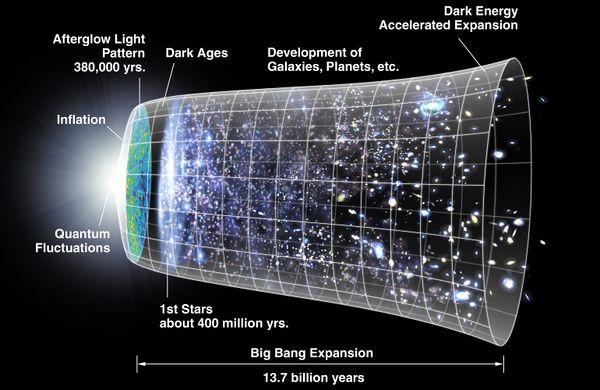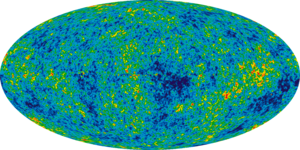الخط الزمني لتشكل الكون
This is a timeline of the formation and subsequent evolution of the Universe from the Big Bang (13.799 ± 0.021 billion years ago) to the present day. Times are measured from the moment of the Big Bang.
. . . . . . . . . . . . . . . . . . . . . . . . . . . . . . . . . . . . . . . . . . . . . . . . . . . . . . . . . . . . . . . . . . . . . . . . . . . . . . . . . . . . . . . . . . . . . . . . . . . . . . . . . . . . . . . . . . . . . . . . . . . . . . . . . . . . . . . . . . . . . . . . . . . . . . . . . . . . . . . . . . . . . . . .
The first second
-13 —
–
-12 —
–
-11 —
–
-10 —
–
-9 —
–
-8 —
–
-7 —
–
-6 —
–
-5 —
–
-4 —
–
-3 —
–
-2 —
–
-1 —
–
0 —
Planck epoch
- ca. 0 seconds (13.799 ± 0.021 Gya): Planck Epoch begins: earliest meaningful time. The Big Bang occurs in which ordinary space and time develop out of a primeval state (possibly a virtual particle or false vacuum) described by a quantum theory of gravity or "Theory of Everything". All matter and energy of the entire visible universe is contained in an unimaginably hot, dense point (Gravitational singularity), a billionth the size of a nuclear particle. This state has been described as a particle desert. Other than a few scant details conjecture dominates discussion about the earliest moments of the universe's history since no effective means of testing this far back in space-time is presently available. WIMPS (weakly interacting massive particles) or dark matter and dark energy may have appeared and been the catalyst for the expansion of the singularity. The infant universe cools as it begins expanding outward. It is almost completely smooth, with quantum variations beginning to cause slight variations in density.
Grand Unification Epoch
- ca. 10−43 seconds: Grand unification epoch begins: While still at an infinitesimal size, the universe cools down to 1032 kelvin.
حقبة الفوتونات
Cosmic Dark Age
Renaissance
- 600 million years: Renaissance of the Universe—end of the Dark Ages as visible light begins dominating throughout.
حقبة المجرات
- 1 billion years (12.8 Gya, z=6.56): Galaxy HCM-6A, the most distant normal galaxy observed, forms. Formation of hyper-luminous quasar SDSS J0100+2802, which harbors a black hole with mass of 12 billion solar masses one of the most massive black hole discovered so early in the universe. HE1327-2326, population II star, speculated to have formed from remnants of earlier Population III stars. Visual limit of the Hubble Deep Field.

